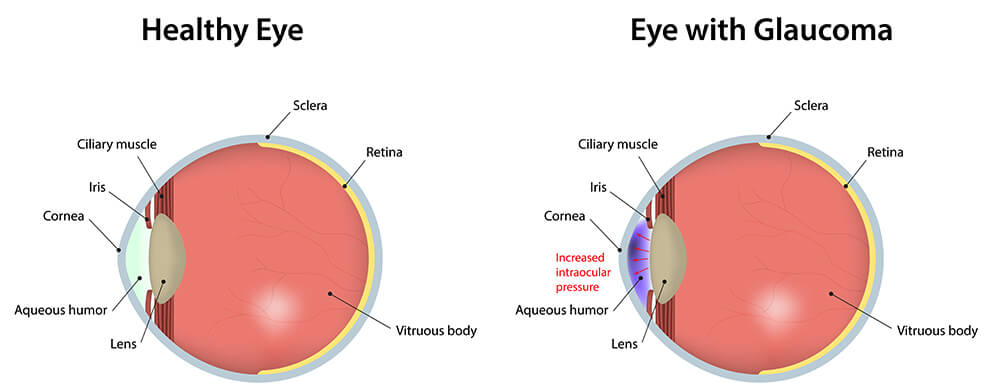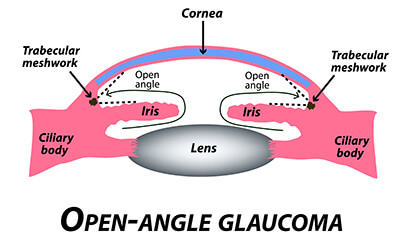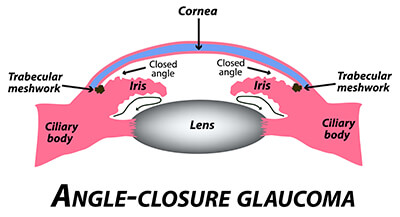Glaucoma Treatment
What is Glaucoma?

Glaucoma is a disease of the optic nerve—the part of the eye that carries the images one sees to the brain. The optic nerve is made up of many nerve fibers, like an electric cable containing numerous wires. When damage to these fibers occurs, blind spots develop. These blind spots, however, usually go undetected until the optic nerve is significantly damaged. If the entire nerve is destroyed, blindness results.
Glaucoma is usually a slow, painless loss of vision. Most patients do not notice any changes in their vision until the more advanced stages, which is why this disease is most often discovered during routine exams. Early detection and treatment by your eye care provider are the keys to preventing optic nerve damage and irreversible vision loss from glaucoma.
Glaucoma is the leading cause of blindness in the United States, especially for older people. Most vision loss from glaucoma, however, can often be prevented with early detection and treatment.
What Causes Glaucoma?
To maintain a healthy level of pressure within the eye, a small amount of fluid called aqueous humor is constantly produced while an equal amount flows out of the eye through a microscopic drainage system.

Because the eye is a closed structure, if the drainage system (sometimes called “the angle”) is blocked, the excess fluid cannot flow out of the eye properly. Fluid pressure within the eye increases, pushing against the optic nerve and causing damage.
What are the Different Types of Glaucoma?
Chronic open-angle glaucoma is the most common form of glaucoma in the United States. The risk of developing chronic open-angle glaucoma increases with age. The drainage angle of the eye becomes less efficient over time, and pressure within the eye gradually increases, which can damage the optic nerve. In some patients, the optic nerve becomes sensitive even to normal eye pressure and is at risk for damage.
Typically, open-angle glaucoma has no symptoms in its early stages, and vision remains normal. As the optic nerve becomes more damaged, blank spots begin to appear in one’s field of vision. Patients, however, typically will not notice these blank spots in day-to-day activities until these blank spots become large.

Closed-angle or narrow-angle glaucoma is a bit different. Some eyes are formed with the iris (colored part of the eye) too close to the drainage angle. In these eyes, which are often farsighted, the iris can be sucked into the drainage angle and block it completely. Since the fluid cannot exit the eye, pressure inside the eye builds rapidly and can cause an acute attack of closed-angle glaucoma.

Symptoms May Include:
- blurred vision
- severe eye pain
- a headache
- rainbow-colored halos around lights
- nausea and vomiting
This is a true eye emergency. If this type of glaucoma is not treated quickly, blindness can result. Unfortunately, two-thirds of those patients with closed-angle glaucoma develop it slowly without any symptoms prior to an attack.
Who is at Risk For Glaucoma?
There Are Many Risk Factors For Glaucoma:
- age
- elevated eye pressure
- family history
- African or Spanish ancestry
- farsightedness or high nearsightedness
- past eye injuries
- thinner central corneal thickness
- general health problems including diabetes, migraine headaches, and poor circulation
How is Glaucoma Detected?
A complete examination by an eye care provider is the best way to detect glaucoma. A glaucoma screening that checks only the pressure is not sufficient to determine if one has glaucoma. In addition to checking the eye pressure, an eye care provider may inspect the drainage system (angle) of the eye, test the peripheral vision, and even obtain photographs or computerized imaging of the optic nerve. Furthermore, these tests may need to be repeated on a regular basis to monitor changes.
How is Glaucoma Treated?

As a rule, damage caused by glaucoma cannot be reversed. Eyedrops, laser surgery, and surgery in the operating room are used to help prevent further damage. In some cases, oral medications may also be prescribed. With any type of glaucoma, periodic examinations are very important to prevent vision loss since glaucoma can progress without the development of new symptoms.
Adapted from the American Academy of Ophthalmology


